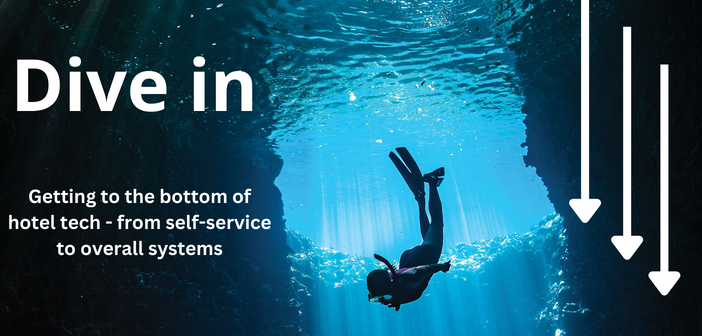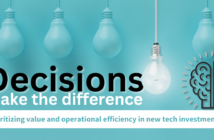Getting to the bottom of hotel tech – from self-service to overall systems
When clients ask veteran consultant John Burns what the hotel industry will be like in, say, five to eight years, the answer is an honest and quick “Who knows?”
Now is the time, said Burns, president of Hospitality Technology Consulting, for talking in units of months, rather than years, especially when it comes to technology. Sure, there’s an interest in strategic planning rather than tactical response. “But, the strategic vision is clouded by the fact that you’re trying to do long-term strategy in a fast-changing world.”
Across industries, businesses have spent the recent season in rapid iteration and creative solutioning. For hotels and hoteliers, that means attempting to respond to ever-evolving guest expectations and demands, and improving experiences while remaining competitive. Technologies aimed at reducing contact, eliminating friction, increasing efficiency, strengthening hygiene, providing virtual reality insight, offering personalization, and making up for reduced staff have become increasingly popular. But, what do guests want to see long-term? How do hotels strike the right balance between high tech and personal touch? And when might it best to hold off rather than dive in?
With cloud-based systems, Burns said, new technologies may be more accessible and affordable than ever. “But, the ability to afford them is tempered by the fact that we don’t have as many staff members to install and operate them,” he said. “Every opportunity comes with a little bit of a dilemma.”
 MUST-HAVE OR MAYBE NOT?
MUST-HAVE OR MAYBE NOT?
In 2022, Oracle Hospitality and Skift released “Hospitality in 2025: Automated, Intelligent… and More Personal,” a survey of more than 600 hoteliers and 5,000 consumers across the globe. The report admits that tech comes and goes, “and what’s trending and hot today may change by 2025.” But, the revolution underway is about something bigger.
“Technology isn’t removing humanity from hospitality; it’s allowing hotels to become more hospitable in a holistic sense,” the report states. “That means guest personalization at every stage of the travel journey. It means changing labor models to attract and retain workers by giving them tools that align with their interests and capabilities. And, it means hoteliers are moving away from a one-size-fits-all approach to selling experiences and allowing travelers to choose the size that fits them.”
THE PEOPLE HAVE SPOKEN
In terms of must-have technologies, the report showed that 53.6% of travelers would like to see contactless check-in and checkout be permanently adopted during the next few years. Just under half (49.1%) cited contactless payments as a key offering they want. Other technologies they’d like to see continue to be offered include mobile guest services (39.3%), work-from-anywhere hotel deals (27.1%), less-frequent room cleaning (17.1%), and work-from-hotel common spaces (16.4%).
As for hotel executives, 34.4% said they were already “heavily invested” in contactless self-service technology to reduce costs, assist guests, and increase operational efficiency. Another 26.6% were just beginning to invest, and still another 14.8% planned to do so within the next year.
Almost 45% of travelers responding to the survey listed on-demand entertainment access as the top must-have for an amazing hotel stay. That was followed by voice controls (43.2%), use of personal devices for hotel access (34.4%), automated comfort controls (25.4%), and smart mirrors/interactive walls to replace TVs (17.6%).
And, there’s evidence that hotel executives recognize these desires. The top-five technologies they’d be most likely to implement by 2025 are the same, though in slightly different order. On-demand entertainment access still tops the list at 45.1%, with guests using their personal devices for access at 41.1%.
DIGGING DEEPER
Meanwhile, the “2022 Hotelier Technology Sentiment Report,” from Stayntouch in partnership with graduate students at NYU School of Professional Studies Tisch Center of Hospitality, showed that the number of popular hospitality technologies used by hotels increased 31% between the start of the pandemic and the end of 2021. That number was projected to increase by an additional 19% in 2022. Areas expecting growth include contactless experiences like self-service check-in, in-room technology, mobile keys, and digital payments – as well as additions to automation tools, guest messaging and, chatbots. Contactless check-in and checkout increased by 66% during the pandemic, according to the study, and guests expect to see this as an option, even if they don’t intend to use it. Offering this option allows guests to “choose what is appropriate for them.”
But, there’s a catch. According to the report, independent hotels often are more reluctant to implement new technologies than branded properties due to relatively high upfront investment costs, creating “a gap in the ability to deliver guest experiences and meet guest expectations.”
CONSIDERING THE BIGGER PICTURE
Mark Fancourt, founder and principal consultant of TRAVHOTECH, speaks of technology trends beyond self-service and mobility, encompassing overall business operations. He’s seen a recent increase in discussions around ancillary revenue. “There’s a visibility now into wanting to commerce all of the products and services that a hotel might have to offer, as opposed to just the guest room,” he said. Too often, he added, these things aren’t offered to guests in a cohesive way, which “leaves a lot of money on the table for the industry.”
The industry’s technology has traditionally been siloed, Fancourt said, which exacerbates the problem, and bringing it together as “total commerce” also requires operational focus. For smaller hotels, this might not be as pressing. But the more services offered, the more imperative this becomes.
Coming from a business background, Fancourt said, he has interesting and enjoyable conversations with clients around the bigger picture of technology.
“If I had a dollar for every time someone said to me, ‘I need a new PMS,’ I’d be a very wealthy man,” he said. “But, what I always say to customers that I work with is, ‘Well, do you?’ Maybe you need to look at the way you want to be doing business, and the types of products and services you want to offer to both your customers and your staff. Then we can determine what technology you need. It might be a PMS. It might not be. Let’s find out.”
In general, Fancourt continued, “Our industry is about a very big basket of technologies coming together to deliver the overall experience.” The industry can be self-deprecating in terms of technology, he said, considering itself slow to adopt. “But, that’s not what I find. I’m often pleasantly surprised at the enthusiasm and willingness to try the new thing and to do the new things, and the internal belief of their capability to deliver and execute on it. It’s quite the opposite of what you hear in the mainstream industry-speak.”
When it comes to deciding on technology, Fancourt’s approach is nothing if not pragmatic. “My two key questions are this, he said. “What type of guest experience do you want to provide? And what type of staff experience do you want to provide?” Additionally, a third question that isn’t asked often enough, he said, is “How do I want to look at the future of my manpower models?” The future of technology will drive a whole set of workforce roles that currently can’t even be imagined. “What do you want your future job roles to look like, particularly when you’re challenged for willing employees?” he asked. “These things all drive the toolset.”




